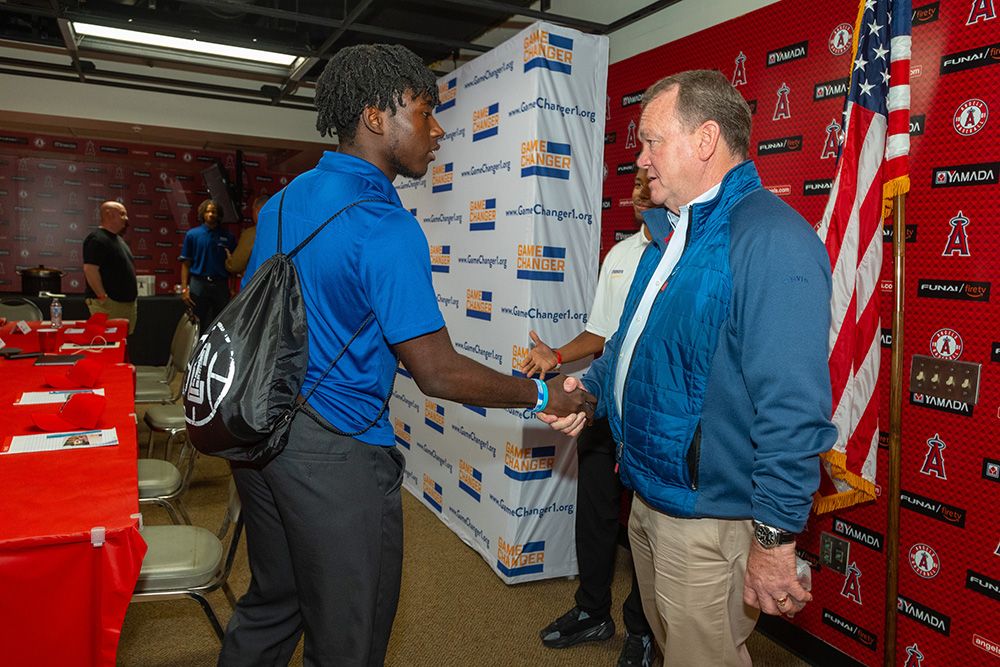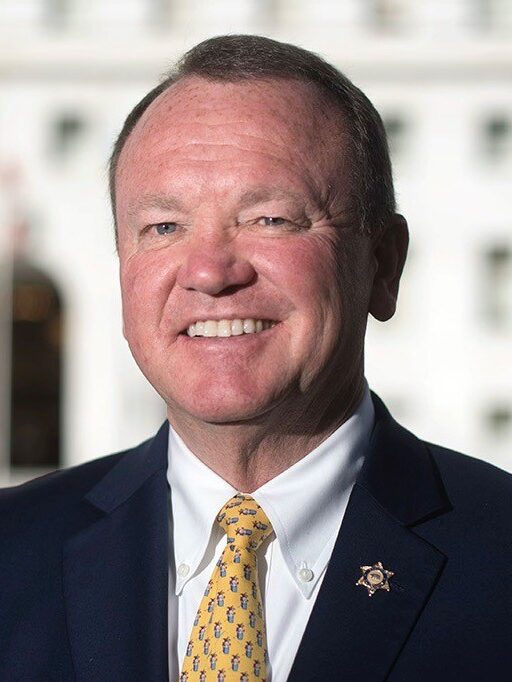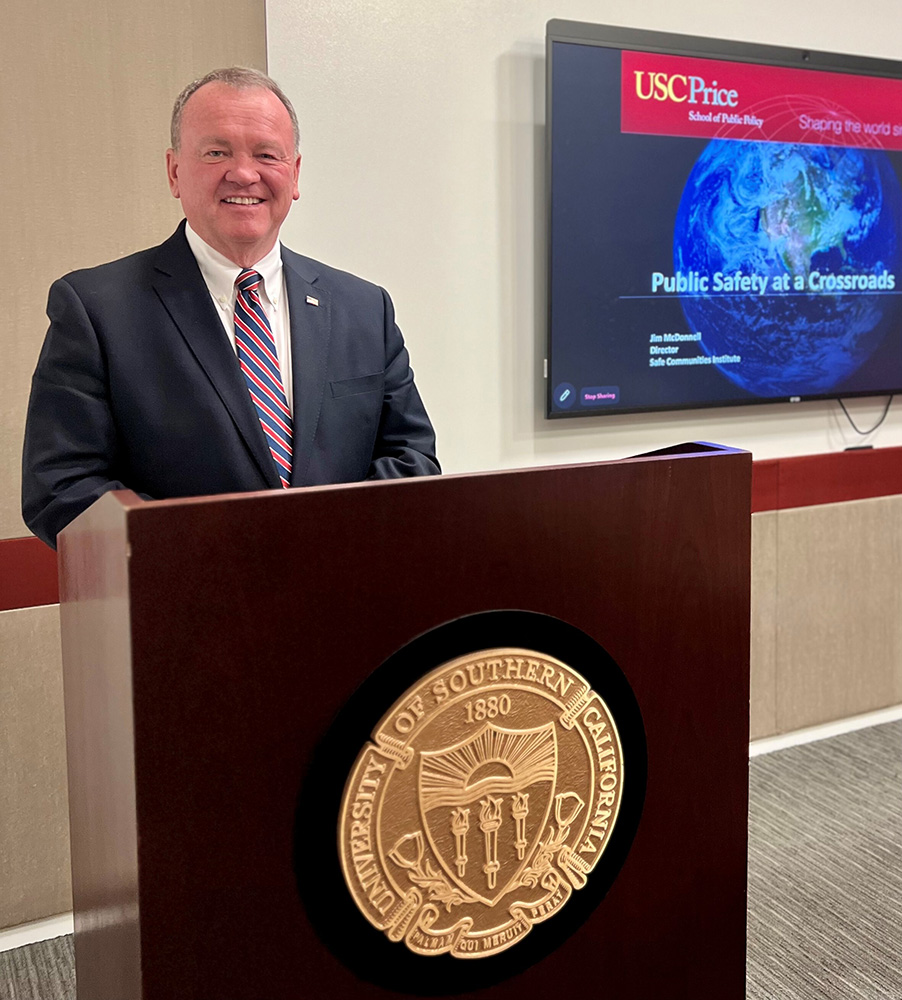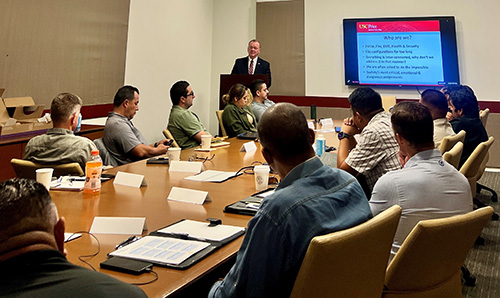A new sheriff in town: Jim McDonnell on the future of the Safe Communities Institute
Former Los Angeles Sheriff Jim McDonnell wants to reimagine public safety. As director of the USC Price School’s Safe Communities Institute, he seeks to broaden the audience beyond law enforcement.

When Jim McDonnell took over the leadership role at the USC Sol Price School of Public Policy’s Safe Communities Institute (SCI) earlier this year, the former Los Angeles County Sheriff brought with him more than 40 years of public safety experience. As the first person to serve in senior executive leadership roles in the three largest policing agencies in Los Angeles county – the L.A. County Sheriff’s Department (LASD); the L.A. Police Department (LAPD); and the Long Beach Police Department (LBPD) – he is uniquely positioned to lead the Institute.
SCI has itself shifted its focus over its 75-year history. In 2015, it pivoted to comprehensive approaches to complex public safety concerns, including the sometimes-fraught relationship between law enforcement and community members – while continuing to provide research, education and collaboration among stakeholders to advance public safety strategies, policies and programs.
We sat down with McDonnell to learn about the new energy and priorities – along with new audiences – he envisions bringing to SCI.
What is your vision for SCI?

I believe we have tremendous potential to go far beyond where we’ve been historically, to become the top public safety think tank on the West Coast – one with research capabilities that provide practical educational experiences and thought leadership on critical issues in public safety. SCI will build on our great foundation – first as the Delinquency Control Institute, which focused on juvenile delinquency in L.A. after World War II, and then, in a post-September 11th world, as a center focused heavily on counterterrorism and homegrown violent extremism. Now, there is an opportunity to address the current needs of senior public safety officials.
I’m very excited and optimistic about the Institute’s ability to remain flexible and adaptive to emerging threats and trends throughout the nation, while bringing the best and brightest minds on these topics together to come up with workable solutions that can be deployed immediately.
In today’s challenging public safety environment, we’ll address issues like recruitment and retention, employee wellness, the dramatic increase in violent crime in many cities across the nation, police legitimacy, cybersecurity, and a variety of other concerns facing all Americans. That includes expanding the focus for our audience from police to also include fire, paramedic services, emergency management, health care, mental health professionals, and private security leaders.
Why does the audience for SCI’s programs need to be expanded?
We talk about public safety holistically – and with the goal of bringing all those with a role to play together. That hasn’t been done traditionally, but it can become an educational best practice model for in-service training, as well as advanced and executive level education for police, private security professionals, fire, EMS and health-care practitioners.
I recently taught a class on emerging trends and threats in American society where I drew heavily on my policing perspective. However, we had a wide array of practitioners from different specialties within the public safety discipline: a veterinarian who deals with K-9s; an emergency-room trauma surgeon, who also administers a county health department; a mental health specialist at a nonprofit who works on homelessness, among many others. We want diversity of thought, specialty and expertise. When we share stories in a class, and people weigh in from their own perspectives, it provides everyone with another level of depth to the conversation that we wouldn’t have if the class was exclusively police officers, or firefighters.
Eventually, we’d also like to get community members involved who are active in dealing with public safety issues, along with government leaders at the local, state and federal levels.
You were a featured speaker at a recent USC Price School event about safety issues on L.A. Metro. In public transit, as with many issues, riders are ranking public safety as the top issue. Why is safety on everyone’s minds, in so many contexts?
There’s a balance that we continuously deal with in American society. When things are going well, and crime is relatively low, we tend to focus on civil liberties. When crime goes up, we then focus on public safety as a priority.
In Los Angeles in 2019, we should have been celebrating 50-year lows in crime. But a short time later, we saw a turnaround everywhere in America – including a 30% increase in the U.S. murder rate between 2019 and 2020, the largest single year increase in over a century, according to the CDC. It was exacerbated by negative attitudes towards police and policing in general. Police officers across the country did not feel supported – in fact, they felt demonized. The lasting impact of this period in American policing will be felt for generations.
We saw law enforcement being held to task in a way that they couldn’t have anticipated, for doing, in some cases, what they believed they had been trained to do. The public sentiment was harsh, and judgment tended to come out immediately, rather than waiting for an investigation. One of the most significant costs of that is it’s more difficult to recruit and retain the best and the brightest.
Can you explain what happens when that trust breaks down?
When it comes to actions that a police officer takes, how that goes is largely dependent on that community’s perspective on the legitimacy of police. And if the police are not viewed as being there to serve the common good, but rather in some more nefarious way, then they’re not going to get public support to be able to solve crimes – particularly violent crimes, which is so necessary in the investigation of any significant case. If you don’t get public help and support, then the chances of getting closure are reduced dramatically.

Today, we also have the ability to use technology in so many different forms that we never had in years past. But with that comes added responsibility. And while technology – for example, body cameras – can make us more efficient and effective, ultimately policing is, and always will be, a people business.
If we don’t have the support of the people that we have the privilege to serve, then we’re not able to do the job that they expect us to do.
Many who were outraged after the murder of George Floyd may push back and say law enforcement needed reform. But it sounds like there have been some negative and unintended consequences.
The number one responsibility of government is public safety. It’s foundational for everything else that we do. Things that are seemingly simple, such as riding the train or the bus to go from point A to point B, going to and from home and school, or going shopping – if you feel like you’re going to be attacked, then you’re going to avoid that.
The implications of that are pretty dramatic. Kids aren’t going to go to school; they’re going to stay away. People aren’t going to visit stores and support the local businesses in the neighborhood; they’re going to find a way to go somewhere else where they feel safer. People, and particularly core businesses, are going to move.
For example, for too many years in Los Angeles, we’ve seen food deserts where people have to shop at the corner liquor store, because there were no available supermarkets. A lot of work went into trying to remedy that situation. And yet, in such a short period of time we have seen that effort undermined by the disruptions that are occurring in so many cities.
In cities like San Francisco, we see the dysfunction when police aren’t supported by elected officials, by the community and by the media. We see businesses leaving the city; neighborhoods being abandoned; public intoxication; open use of drugs – all types of public disorder and adverse quality of life issues and there’s seemingly no means of accountability.
What’s the effect on those who are working to keep communities safe?
People expect that the government is in place to fix things like this, and that’s not happening. The police officers, firefighters, EMS and private security who work to protect people and property are very frustrated that the tools that they have traditionally used to maintain order, and to hold people accountable, have been taken away in a relatively short period of time. Meanwhile, the people that in some cases wrote the laws are now protesting the police for enforcing those same laws.
That’s hard to quantify or explain until you’re out there doing the job. That’s something our instructors and the people who enroll in our programs understand.

You mentioned the research goals of SCI – what’s an example of research that will have some fairly immediate benefits for public safety?
We are currently working on a project that would formally look at body camera footage from LAPD in an effort to evaluate behavior during a traffic stop. The goal is to provide feedback on potential training opportunities that might change the interaction between the officers and the public in a more positive way.
Of course, we would be sensitive to tactics and the type of call and put everything in context appropriately. By viewing the videotape of body-worn cameras and dash cameras, we would have an ability to be able to look for indicators of and behaviors that could be potentially modified in a way to ensure better outcomes.
Can you tell us about some other recent developments at SCI?
We are in the final stages of putting together a very robust advisory board of some of the most significant leaders in the nation in the fields that we’ve mentioned, including senior security leaders for Disney and for Coca Cola and top-level staff from the International Association of Chiefs of Police. In addition, we will have several highly regarded trauma physicians, psychologists, cyber-crime experts, elected officials, media experts, and others who bring tremendous insight and expertise to the Institute. That puts us in a place where we’re able to leverage fantastic contacts both for our instructor cadre as well as participants in our programs.
We’re working to create and maintain a strong alumni network association, so those who have been through our programs will benefit in an ongoing way from the experiences of our peers across the nation.
These are just some of the steps we’re taking to realize our goal of being the top public safety institute on the West Coast: a think-tank that offers both executive classes and mid-level career classes and establishes centers of excellence for a number of critical topics. That’s the long-term vision.